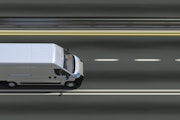How Smart Video Fuels Smart Business
Learn how video solutions with intelligent analysis capabilities can help benefit your drivers and enhance safety programs.
Read more
From patrol cars to interceptor SUVs and other emergency service vehicles, law enforcement agencies across the United States have specific needs and high expectations of their fleets. Police fleets, in particular, are expected to react and respond immediately in any situation—which puts intense pressure on them to be always at the ready. Yet, aging cars and trucks, combined with limited budgets for upgrades or replacements, can make it difficult for first responders to optimize operations and help improve vehicle health.
In addition, law enforcement agencies are being bombarded with a plethora of new vehicle models and technology options, including next-generation engine technology, functionality, bigger and more versatile platforms, semi-autonomous and robotic cars, and built-in WiFi connectivity, just to name a few.
To help them address these challenges both in the near and long term, more law enforcement agencies are turning to fleet management systems.
According to an annual survey from the Government Fleet, the top concern for public safety fleets is aging vehicles and the budget for replacement.[1] To improve fleet lifecycle management and simultaneously support enhanced public and officer safety, many police fleets are investing in telematics. Let’s review some of the common challenges police fleets face and how the right technology can help.
Police officers need to be fast, whether responding to an emergency or in pursuit of another vehicle—and, though speeding is unavoidable at times, it does increase risk for officers, their cars and others on the road. Officers also need to communicate quickly and accurately while at the same time keeping themselves safe behind the wheel.
Digital fleet data can help improve driver and vehicle safety, but it’s likely collected from multiple sources such as CAD systems or aided dispatch. Telematics can help fleets integrate these data streams to provide accurate analytics and reporting around:
This enables fleets to get a holistic view of vehicle locations, routes and schedules. And, if something happens in the field, like an occurrence of speeding with the light bar on, the back office is alerted to confirm whether the incident is a true emergency that requires the dispatching of additional resources.
In this webinar, "Reducing Response Times with Smart Fleet Management", 41% of officers reported that their biggest fleet challenge is keeping up with vehicle maintenance. This makes sense, given fleets are tasked with getting the best performance out of each emergency vehicle and extending its life for as long as they can. Especially since police fleet vehicles face increased wear and tear due to the nature of public safety work and the circumstances under which these vehicles must operate. Higher repair costs and more frequent repairs put further strain on already pinched budget dollars.
GPS fleet tracking software solutions can help public safety fleets stay on top of vehicle health with proactive maintenance capabilities such as:
Those in the back office can quickly view alerts to determine if a particular diagnostic trouble code requires pulling a vehicle out of the field immediately to get fixed, or if it can wait until the next maintenance interval. Alerts can also be set up around harsh driving, which directly impacts the frequency of brake, rotor, tire and suspension replacements—ultimately helping to control fleet operation costs and inform decisions that will impact the bottom line.
Law enforcement vehicles are subject to wear and tear far above the norm, which can require costly maintenance, repairs and part replacement. Budget-strapped police forces must get the maximum number of miles and service out of each police car, but it shouldn’t be at the expense of those operating the vehicles, often at high speeds.
Telematics can help increase efficiency while lowering operational expenses by enabling fleet managers to:
Police fleet managers can struggle to get a clear picture of the where, why, when and how related to fleet vehicles and assets, especially when it comes to applying insights to improving operations. They can be especially challenged when it comes to simultaneously viewing the location of all vehicles and equipment, tracking the movement of generators, mobile command trailers, digital message boards and other assets, and staying on top of overall inventory status.
Telematics technology can help law enforcement fleet operators:
The scorecard feature enables a graphical user interface to show performance over time—giving fleets the ability to view performance quarter over quarter, month over month, and year over year. This allows for measurement of an assortment of KPIs and automated reports and alerts to deliver that information where and when it’s needed.
Sixty six percent of attendees in a recent police fleet webinar indicated that public perception is extremely important to their law enforcement work. Today more than ever, there’s an increased focus on public safety and an increased magnifying glass on how public fleets operate. Poor driving from a police vehicle can negatively impact reputation, especially if it’s a recurring event, and aggressive driving with the light bar turned off can put the public at risk and pose a legal liability.
Telematics can help police fleets to better manage public perception by allowing them to:
Public perception also ties to responsiveness. Technology helps fleets to dispatch the closest officer almost immediately and better coordinate mutual aid. When a disaster happens, it’s more than just a police fleet responding to the emergency—telematics enables police fleets to share their response information with other mutual aid agencies, which can aid in streamlining response time and integrating efforts in near real time.
In the webinar poll, 31% of attendees indicated they want to improve vehicle health monitoring, and 28% want to achieve more efficient route planning. Connected vehicle technology lets fleets achieve these goals with tools that promote improved operations:
To learn more about how fleet management solutions can help police fleets, download this free ebook – 3 Ways Telematics Improves Fleet Management for Law Enforcement.
[1] https://www.government-fleet.com/operations/340772/2019-benchmarking-statistics
Tags: Government, Public works




Find out how our platform gives you the visibility you need to get more done.
Learn how video solutions with intelligent analysis capabilities can help benefit your drivers and enhance safety programs.
Read moreAre you ready for vehicle tracking? Go through our checklist to learn the signs you’re ready to add fleet tracking to...
Read moreTechnology adoption helps fleets navigate operational obstacles. Learn what fleet management industry technology trends...
Read moreLearn how telematics can lead to operational improvements.
Read more
Get your free 2024 Fleet Technology Trends Report and see how organizations are: